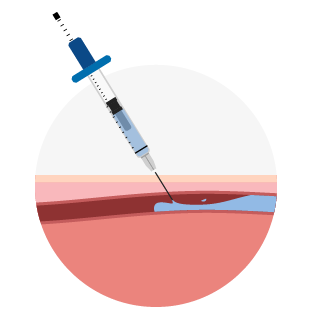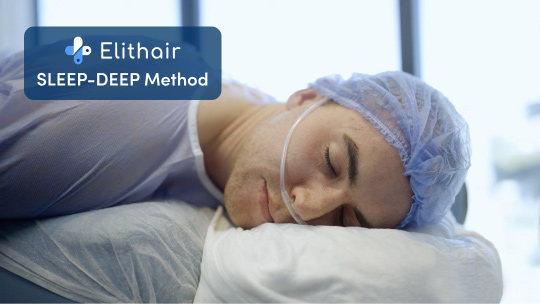
Hair Transplant Anaesthesia: Experience Comfort with the Sleep-Deep Method
At Elithair, Dr. Balwi and his medical team ensure your comfort during every hair transplant procedure by using the innovative Sleep-Deep Method.
This advanced technique involves a 15-minute sedation period, allowing you to drift into a deep, pain-free sleep before your local anaesthetic is applied. Ideal for anxious patients, the Sleep-Deep Method not only eases nerves but also ensures a more relaxed and comfortable treatment experience for everyone.
Take the first step towards restoring your confidence. Start your free hair analysis today—it only takes 2 minutes to learn more about your personalised hair restoration journey!

Why Is Hair Surgery Anaesthesia Essential?
Hair transplant anaesthesia is a key step in ensuring your procedure is completely comfortable and pain-free, tailored specifically to your needs.
At Elithair, we’re proud to be one of the few clinics in Turkey offering general anaesthesia before applying local anaesthetic. This innovative approach is ideal for patients with high pain sensitivity or those feeling anxious about the procedure.
With the Sleep-Deep Method, you’ll drift into a relaxed state of deep sleep, allowing our specialists to perform the anaesthesia without causing any discomfort. This ensures a stress-free, painless experience from start to finish, letting you focus on the exciting results to come.
Hair Transplant Sedation: How It Differs from Traditional Anaesthesia
Elithair’s Sleep-Deep Method offers a revolutionary approach to hair transplant sedation, delivering immediate and painless results. This advanced technique uses intravenous sedation that works at a shallow depth beneath your skin, ensuring comfort from the moment it’s administered.
In just 15 minutes, our specialists at our hair loss clinic in Istanbul apply your local anaesthesia, completely pain-free.
Unlike traditional hair transplant anaesthesia, which penetrates deeper tissue (up to 0.39 mm) and can cause discomfort while taking longer to take effect, the Sleep-Deep Method is designed to prioritise your comfort and efficiency. It’s a modern solution for a smooth, stress-free procedure.
Your Advantages With Elithair
An Alternative to Sedation: The Needleless Comfort-In Method
If hair transplant anaesthetic with sedation is not an option for you, the needleless Comfort-In method offers a low-pain, needle-free alternative. In this way, your health is prioritised, and you’ll still be able to enjoy your hair transplant procedure virtually pain-free as your hair follicles are extracted and implanted on the respective areas of the scalp.
The Comfort-In System is used under the following conditions:
-
- Patients who have eaten or drunk shortly before the procedure
- Elderly individuals
- Patients with pre-existing medical conditions (e.g., organ disease)
- Those with allergic sensitivities to sedation drugs
This innovative method injects the anaesthetic directly under the scalp to a depth of just 0.15 mm, offering a fast-acting solution with a broad area of effect. It’s a cutting-edge option that ensures your comfort without compromising on safety or results.
Why Choose Elithair for Your Hair Restoration?
At Elithair, we prioritise your comfort and peace of mind with our advanced hair transplant anaesthesia method, featuring sedation through the Sleep-Deep Method.
This innovative approach, designed to induce a relaxing deep sleep, ensures your procedure is completely pain-free and stress-free. It’s especially ideal for patients who may feel anxious about the treatment, allowing them to experience the journey to restored hair with ease and confidence.
Still have questions? Your dedicated Elithair expert is always here to provide guidance and support—contact us today!
Contact Us
FAQ
Is Hair Transplantation Anaesthetic With Sedation Really Completely Painless?
Yes, since you are in a deep sleep during the local anaesthesia, you will not feel any pain. The anaesthesia then also ensures that you will not feel any pain during the hair transplant procedure after you wake up.
Which Is Better – The Hair Transplant Sedation or the Comfort-in Method?
Hair transplant anaesthesia with sedation guarantees 0% pain and is used at Elithair, the largest hair clinic in the world.
If sedation is not possible in your case for health or safety reasons, the Comfort-In system offers the perfect alternative to experience a painless hair transplant. The needleless procedure is also suitable for anxious patients.
Is Local Anaesthesia Dangerous?
The procedure is not dangerous. For your absolute safety, we will ask you about existing allergies and pre-existing conditions before the treatment.
We will then take these into account during your hair transplant.
What Happens When the Effect Wears Off?
In rare cases, it can happen that the effect of the anaesthesia wears off during the procedure. This is due to the fact that each person has a different metabolism.
If this happens, our specialists will give you another dose of the anaesthetic.